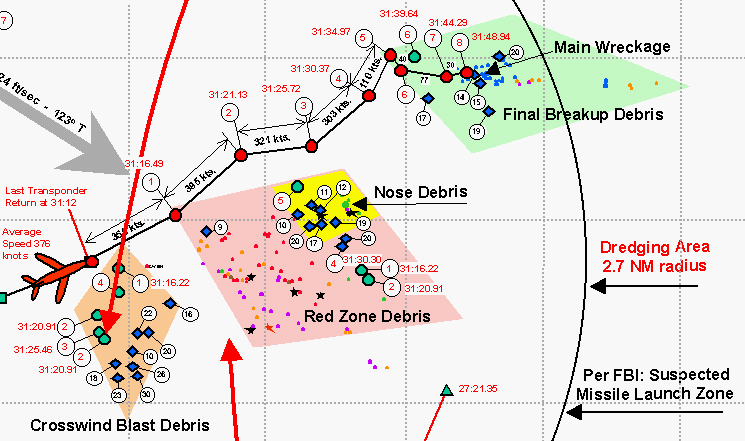Ok, now on to points that we disagree about.
I don't care what you "believe", Lurker. Belief has NOTHING to do with it.
Let's change the word "believe" to the word "know". I KNOW that if the wings were still on the aircraft, it wasn't falling like a rock would fall. It WAS "flying" in such a way that it DID travel significantly furthur than the nose of the aircraft. In fact, the plane veered to the northeast off its original line of travel. This is readily apparent from both the radar graphic and the debris field. I'll post the full radar graphic again, and provide a link to the .PDF debris field document.

The facts are that the aircraft had to cover a certain distance and and certain altitude, both of which are known... and to do that THE MATH SAYS IT HAD TO REACH THOSE VELOCITIES!
Actually, if you consider the fact that TWA 800 was in a AERODYNAMIC DIVE on its way down, one COULD expect the vertical velocity to reach or EXCEED 450 feet/second.
It is virtually impossible to know when exactly TWA800 began to dive, but we COULD assume that it happened at around the time it lost its nose. The nose section would travel in a purely ballistic manner, as it is shaped similar to a projectile such as a bullet. And just as a bullet would decelerate due to friction with the air, TWA 800's nose decelerated and dropped ballistically. Although there isn't much in the way of radar data for the nose debris, we can see that it did in fact impact much sooner and closer to the separation event than did the main body of the aircraft.
The main body of the aircraft on the other hand went into a DIVE, and although retaining much of its forward motion, accelerated in overall airspeed due to gravity. It is virtually impossible to calculate the exact pitch of the dive due to an astronomical number of variables that are unknown, such as the force due to friction in relation to airspeed and angle of attack, the rate of change of those variables, the exact condition of the aircraft at any given moment, temperature of the air, air density, exact altitude at any given time, airspeed, initial pitch, position (and condition) of control surfaces, etc....
So we can just take a rough guess and assume a downwards pitch of 45 degrees. In fact, if you look at ARAP's Fall Chart, it is apparent that what they are calling a ballistic fall looks more like a 45 degree dive for a period of time. It is not perfectly parabolic as one would see in a pure ballistic fall graph. Given that, we can estimate airspeed and vertical velocity for each sweep of the Islip radar if we were so inclined..
Given that the acceleration due to gravity is still 32 feet/second2, ideally the amount of acceleration in airspeed due to a 45 degree dive is;
Aas = 32 * sin(45) = 22.63 feet/second2
This is in relation to the notion that the airframe is sliding down an inclined plane, where the plane is the air in relation to the airframe. The force of gravity would be applied at an angle of 45 degrees, with the force due to the air against the bottom of the airframe in equilibrium with that component of the force of gravity pushing downwards against it.
To determine the resulting vertical acceleration due to this motion, we can determine that by looking at that component of acceleration in relation to the acceleration in airspeed.
Av = Aas * sin(45) = 16 feet/second2
Now there IS deceleration in the forward direction due to friction caused by air, even though there would be a component of acceleration due to gravity in that direction. This DOES in fact cause the airframe to move in a arc, although not a purely BALLISTIC arc. There is also the fact that as the pitch changes, the vertical acceleration changes as well, increasing towards 32 feet/second2 as the plane appoaches a vertical dive.
Avoiding the calculations (for now) in relation to estimates of altitude taking these factors into consideration, we can simply use Pythagorean's Theorem to see what the airspeed might have been at 20:31:30.
Given the forward speed of 303 knots (511 feet/sec) and assuming a vertical speed of 450 feet/sec, we'll solve for airspeed;
V = sqrt(5112 + 4502) = ~681 feet/sec = ~403 knots = ~464 mph
So it IS possible from looking at the actual airspeed for TWA800 to be going down at 450 feet/sec. In fact, it probably went even faster than that after 20:31:30 where its forward speed had slowed to 110 knots. That is probably what caused the left wing to rip off, along with the fact that there was already structural damage to the aircraft.
So yes, Swordmaker, I can see HOW it COULD FLY at that speed, although the fall IS NOT ballistic. However, the additional speed picked up in the duration of time that its dive was mostly vertical would make up for any amount of altitude that it didn't lose initially in relation to the fact that it was diving rather than falling...
Unless you want to repeal the law of gravity, there literally is not enough time for ANY climb at all.
I don't want to repeal the Laws of Gravity, nor do I find it necessary to do so in order to describe what I just did...